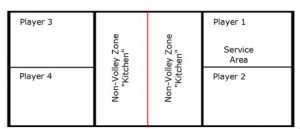The serve is always made diagonally, starting with the right-hand service court and alternating with each serve. The only time a server has a second opportunity if the ball hits the net but still lands fair – called a “let”.

The rules are fairly simple, but easy to break –
- The server must stand with both feet behind the service line and cannot step on the court until they have actually hit the ball.
- The serve must be underhand – the arm must be moving in an downward, then upward motion (not sideways) during the serve movement
- The paddle head must be below the wrist when it hits the ball
- The paddle head must be below the waist when it hits the ball
The best way to start practicing a serve is to first simply swing your arm backwards and forwards holding the paddle. Watch the paddle head – make sure as you start your upward motion that your wrist does not twist. Twisting will cause the ball to move to one side or the other, missing the opposite side service area. As you advance, you can learn how to slice the serve, but first concentrate on developing control.
Players can hit the ball very low in the arm swing– resulting in a low, flat serve; or right below the waist, resulting in a lob (high arcing serve). As you advance, these can be used strategically against your opponent. But to start with, just focus on getting the ball over the net and into the playing field. There will be plenty of time to refine as you become more confident. Like any other paddle sport, a strong serve can allow you to dominate the game!
Source: Villager article by Anahid Gregg

